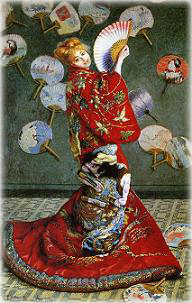Japanese Goods, flowing scents
from the traditional culture in Japan.
Pick up Items
Site Info
This is a free web app. Webアプリ
Add this button to your bookmark.
Japanese Kimono, Top Page
Traditional wear, clothing, dress in Japan
Japanese "Kimono" indicates the styles of all the traditional clothes in Japan that Japanese people wore in the past days. So by the different ages, the differences in the social status of people who wore it, and the region where it was produced, a variety of Japanese kimono appeared and went off. They are from naive kimonos to luxury ones, and have different attractions. Depending on each production, the methods of dyeing and weaving are quite different. Also fabrics are widely varied.
However, in usual meaning, and Japanese kimono which today Japanese people are wearing are bases on the clothes of the Edo period, before the people in Japan were influenced by Western culture. Because of estates of the realm removed and the people acquiring equality, the differences with the social status are reduced. On the other hand, Japanese kimono gave over their positions of the casual wear to Western wear, and kimonos were dropping their positions to costumes only for the special events. So the differences of Japanese kimono are more depending on "Time Place Occasion" in recent days.
For examples, Yukata Robe, which is origin in a robe in the Edo period, is now often worn at the summer festival especially by women. Furisode Dress is worn by young women who have not been married yet. On the other hand, womens who have been married should wear Tomesode Dress. When you go something formal places, Homongi Dress is safe to clear a dress code. Uchikake Dress is worn for a bridal dress.
Fabrics used for Japanese kimono are also widely varied. Cottons are used for Yukata, and it is well absorbing sweats and keeps a body cool. Addition to it, hemp kimonos are also or cooler than Yukata, and worn in the summer. The most of kimonos are made of silk or high-quality silk pongee, so have a pleasant texture and gloss. But a little bit too warm for the summer clothing. Japanese kimono are separated to the three types, "Winter Type", "Spring&Autumn Type", and "Summer Type".
A view of Kimono Pages
How to select a kimonoHow to wear a kimono
→How to wear a kimono1 2 3
→How to tie an obi1 2 3 4 5
→How to tie Taiko Musubi1 2 3 4 5 6
How to use kimono accessories
→How to use an erishin
→How to wear a susoyoke
→How to use a datejime
→How to use a corinbelt
→How to use a maeita
→How to use an obiage
→How to use an obijime
How to fold a kimono1 2
A variety of traditional designs and patterns decorated on Japanese kimono make it more brilliant. For examples, Shibori Zome, the method of dyeing, is tying strings to fabrics before dyeing, and takes the strings off after tinctured. In the result, the parts of fabrics that have been tied by strings are not tinctured, and beautiful gradations appear on the cloths. Yuzen, the method of dyeing, is directly painting pictures on fabrics, and produces detailed and precise designs on a kimono. Nishijin, the weaving-skill using colorful dyed threads inherited in Nishijin of Kyoto, receives high reputation in the world. At a glance, it is misunderstood with a painting, however all the designs in Nishijin are created by combinations of threads.
Japanese kimono is made from only a sheet of fabric; there is no complicated skills of cutting and sewing. It is so simple sewing that people can wash Japanese kimono with turning it back to simple fabrics, and after washing, sew it back again completely as same as before. When you wear Japanese kimono, you can feel its simplicity. There is no upper or lower, only one piece of cloth. Flinging on Japanese kimono dress, and tying an obi belt tightly, you will feel that your back is straightened up.
